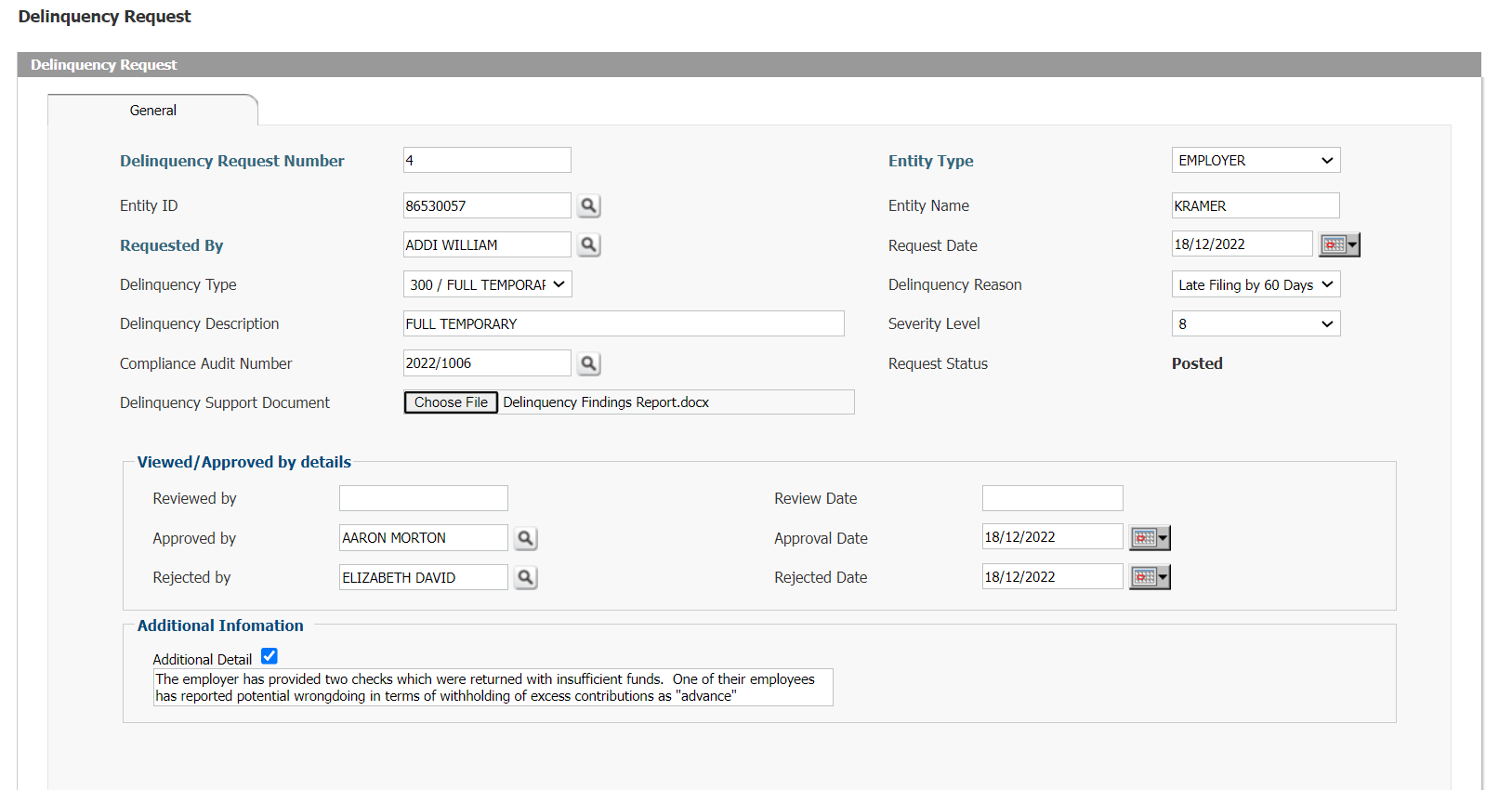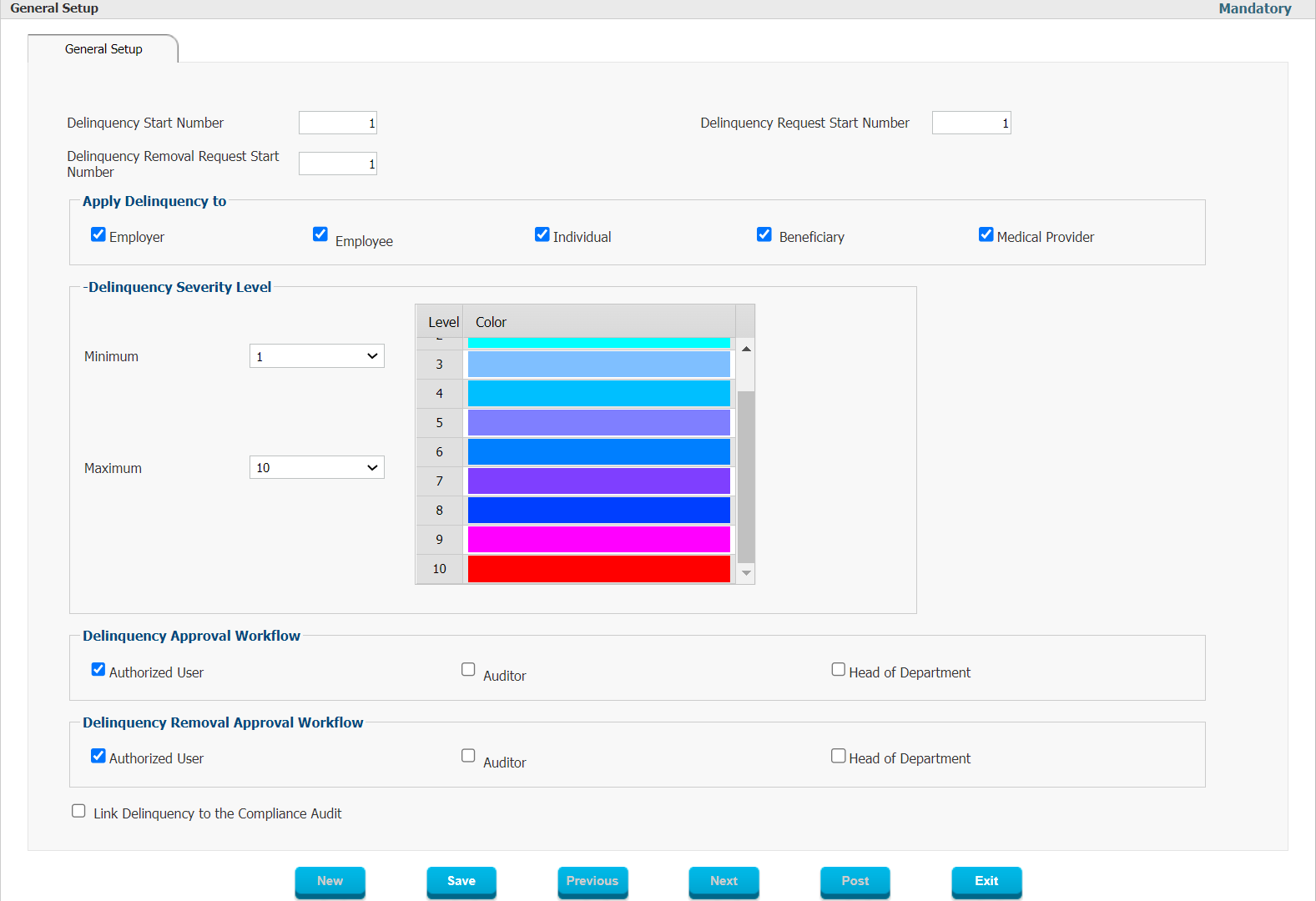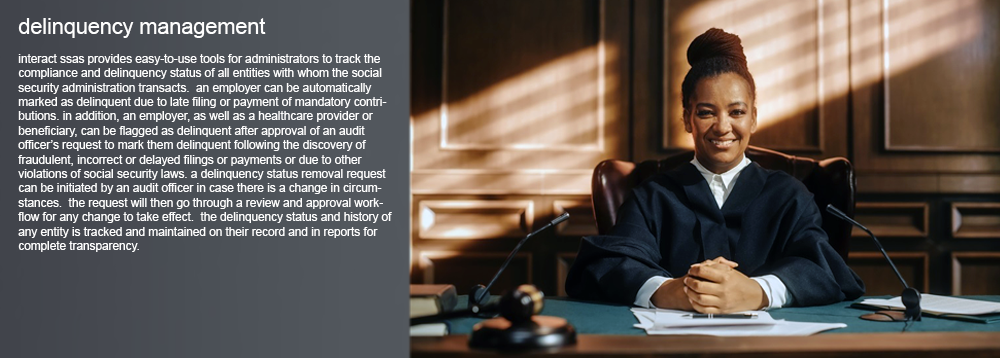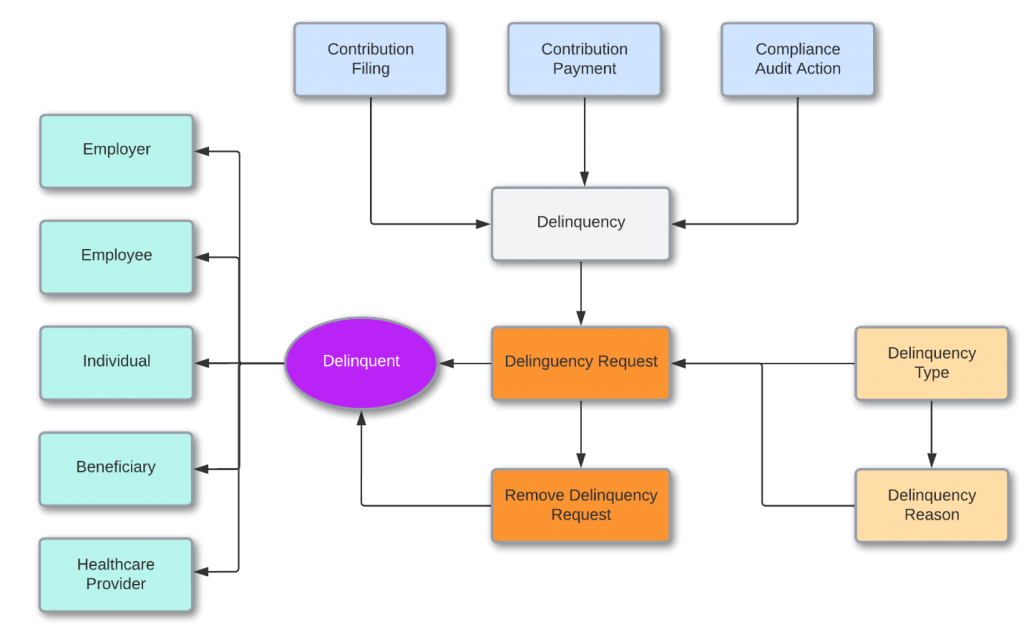Delinquency Management helps Social Security Administrations track and manage compliance by identifying employers, healthcare providers, and individuals who fail to meet social security obligations. This module ensures that entities who do not file contributions, delay payments, or submit fraudulent claims are properly monitored and addressed. Delinquency status can be assigned automatically based on predefined rules or manually by authorized users.
Figure 1: Delinquency framework
Features and Processes
Delinquency Assignment and Management
- Any entities that can be marked as delinquent include employers, employees, healthcare providers, self-employed individuals, voluntary contributors, and beneficiaries.
- Configurable delinquency triggers allow the system to automatically mark entities based on contribution filing and payment compliance.
- Manual delinquency requests can be submitted by authorized officers for violations such as fraudulent claims, or any other compliance violations.
- Compliance auditors can assign delinquency status as an audit action following compliance reviews.
Configurable Rules and Workflow
- Automatic delinquency assignment based on system-defined rules.
- Manual delinquency requests require submission, review, and approval.
- Entities flagged as delinquent appear in the system with corresponding severity levels and status indicators.
- Customizable reasons for delinquency ensure transparency in marking entities.
- System-generated alerts notify relevant parties of delinquency status and required corrective actions.
Delinquency Status and Review
- Once marked, delinquent entities are subject to further compliance actions.
- Social Security officers can review delinquency status to determine appropriate enforcement measures.
- Employers with delinquency status may face penalties, audits, or legal action.
- Healthcare providers who submit fraudulent medical assessments may be subject to investigation.
- Individuals found guilty of fraudulent benefit claims may have benefits revoked and face additional penalties.
Removing Delinquency Status
- Entities can apply for delinquency removal through a structured request process.
- Requests undergo review and must be approved before delinquency status is revoked.
- Removing delinquency does not erase the history; records remain available for auditing and compliance tracking.
Security and Compliance
- Only authorized officers can assign, review, and remove delinquency status.
- Full audit trails track delinquency status changes and actions taken.
- Configurable compliance policies ensure adherence to local social security regulations.
Integration with Other Modules
- Compliance Management: Links delinquency assignment with compliance audits.
- Contribution Filing & Payment: Automatically flags employers failing to file or pay on time.
- Legal and Enforcement Actions: Supports escalation to legal officers and courts for enforcement.
- e-Services Portal: Allows entities to view their delinquency status and submit compliance requests.
Delinquency Management is essential for ensuring compliance within the social security system. By providing structured workflows for automatic and manual delinquency assignment, review, and removal, the module enhances transparency and accountability. Seamless integration with compliance, contribution, and legal enforcement processes ensures that entities adhere to their obligations while preventing fraud and errors in social security administration.
Delinquency Management – Details and Screenshots
- Improve Compliance
- Increase Visibility and Transparency
- Identify & Reduce Errors, Evasions and Fraud
- Maintain Detailed Audit Trails
- Streamline Processes in Audit & Legal Departments
- Exchange Sensitive Data Securely
- Leverage Powerful Reporting
- Empower Audit Officers and Legal Officers
Delinquency Management is a key module in the Interact Social Security Administration System suite of products. It is specifically designed to be flexible enough to support differences in social security legislation for different countries. Its primary goal is to help international social security organizations improve compliance by allowing them to easily identify, track, and manage delinquent employers, healthcare providers, and individuals. Individuals determined to be Delinquent can be employees, self-employed, voluntary contributors, beneficiaries or pensioners, mostly due to fraudulent benefit claims.
Through the seamless integration with Compliance Management, a Compliance Officer or Auditor can select an Audit Action outcome of marking an Employer, Healthcare Provider or Individual as Delinquent.
Key Features:
- Configurable Rules for Automatic Triggers for Assignment of Delinquency Status
- Integrated with Electronic Record for Employer, Healthcare Provider & Individual
- Manual Requests by Authorized User for Assignment of Delinquency Status
- Manual Requests by Authorized User for Removal of Delinquency Status
- Integrated with Compliance Management for Audit Actions
- Configurable Workflow for Review and Approval
- Color Coding by Severity Level
- Configurable Types of Delinquency
- Configurable Reasons of Delinquency
- Configurable Alerts
- Extensive Reporting
The reasons for marking someone Delinquent are fully configurable and vary based on the type of entity:
| Employers | Not Filing Contribution Reports |
|---|---|
| Submitting Fraudulent Contribution Reports | |
| Not Paying or Only Partially Paying Contributions | |
| Any Other User-Defined Reasons | |
| Healthcare Providers | Submitting Fraudulent Medical Assessment |
| Any Other User-Defined Reasons | |
| Individuals | Filing Fraudulent Benefit Claims |
| Submitting Fraudulent Supporting Document | |
| Any Other User-Defined Reasons |

Figure 2: Delinquency Request
The system can be set to automatically mark an employer as Delinquent, or this can be initiated manually through a Delinquency Request.
Key Processes
Assigning Delinquency Status
There are rules and policies that govern the basis of changing the status of an Employer, a Healthcare Provider or an Individual to Delinquent. These delinquency rules and policies vary from country to country.
There are three ways in which a Delinquency is invoked:
(1) Automatic, where, based on specific pre-defined rules, the system will make an Employer or Individual Delinquent, example: if an Employer does not pay the Contributions Filed within 30 days from filing, the system will automatically mark the Employer as Delinquent.
(2) Manually, a user who has uncovered a violation can manually create a Delinquency Request where he/she selects which Employer, Healthcare Provider or Individual should be set to Delinquent and includes the details of the Alleged Violation in the Delinquency Request. In this case the request goes through the workflow and once approved the selected entity will be marked as Delinquent.
In addition, through the Compliance Audit Action in the Compliance Management module, an Audit Officer can select the Audit Action as Delinquent, and the system will mark the selected Employer as Delinquent.
Removing Delinquency Status
To remove the Delinquency status, the user has to go through a process known as Removal of Delinquency, where a Removal of Delinquency Request is raised and then once approved the delinquency will be removed from the selected entity.
Delinquency Framework
The basis of the Delinquency Framework shown is that the Delinquency can be triggered using two modes: an Automatic and a Manual Trigger. The Automatic Trigger of Delinquency is handled using specific Trigger Rules defined at the Setup of the Delinquency Module and at the Policy Level. Once the trigger rules are setup, the system will automatically trigger a delinquency event, which generates a Delinquency Request, and in turn an entity will be flagged as delinquent after review and approval of the Delinquency Request.
Manually triggered Delinquency on the other hand is not linked to any process. In the manually triggered Delinquency, the user has to manually invoke the Delinquency Request and complete the request by selecting the concerned entity, the delinquency type, and delinquency reason. Once the request is reviewed and approved, the selected entity will become delinquent.
Entities – The delinquency process applies to various entities including Employers, Employees, Individuals, Beneficiaries, and Healthcare Providers. Note that the automatic delinquency mode is only applied to Employers as the automatic delinquency is linked to Contribution Filing, Contribution Payment, and Compliance Audit Actions. While the manual delinquency mode is applicable to all entities.
Removing/Revoking Delinquencies – Removing or Revoking a Delinquency process is used to remove an entity from the Delinquency List. Removing a Delinquency is a manual process, where the user has to submit a Delinquency Removal Request, and once the request is approved, the concerned entity will be removed from the delinquency pool/list. Removing an entity from the Delinquency List, does not delete/purge the Delinquency History of the delinquent entity. The delinquency history will remain, even if the Delinquency is removed. The delinquency removal applies only to the current state of the entity.

Figure 3: Configurable Setup for Delinquency Management

Figure 4: Delinquency Tab in Employer Record


